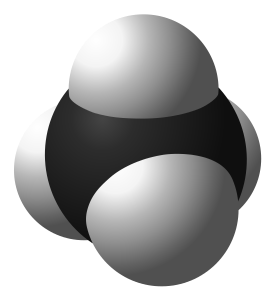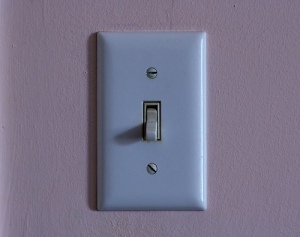Everyone has heard of carbon dioxide. In fact, CO2 has become almost synonymous with climate change. As more CO2 is released to the atmosphere, more of the Sun’s heat is trapped within the greenhouse gas ‘blanket’ surrounding the Earth, warming the land and oceans. It is important to remember, however, that carbon dioxide is not the only greenhouse gas and far from the most potent. As the focus continues to revolve around CO2, other culprits such as methane (natural gas) and nitrous oxide are often left out of the conversation.
This 3D space-filling model makes methane look adorable
Methane is a less cited offender due to its lower concentration (1.8 parts per million versus 394 for carbon dioxide) and shorter lifespan in the atmosphere. That said, the two gases are not equivalent in terms of their impacts. Methane is a much more efficient greenhouse gas, with 25 times more global warming potential than carbon dioxide (nitrous oxide, present in even smaller amounts, is 300 times more efficient!).
Cows contribute large amounts of methane to the atmosphere, mostly through belching
Most projections of carbon emissions focus on greenhouse gases released by humans directly. What they do not take into account are the runaway natural processes that can be triggered by global warming. Feedbacks fall into two categories – negative and positive (don’t confuse these with good and bad – in fact, it’s the positive feedbacks or cascades that are the most dangerous!)
A negative feedback refers to a system constantly trying to reach a certain set point or equilibrium. A good example is the thermostat in your home, which turns on the heat when the temperature is too low and turns it off once it gets too high. A positive feedback, on the other hand, is a process that once initiated drives itself forward. For example, if you cut yourself, signal chemicals are released to activate platelets in your blood, which form clots. Each activated platelet releases more of these chemicals, activating other platelets and allowing clotting to proceed faster.Thus, runaway positive feedbacks that may be initiated by even minor changes in global temperature can be incredibly dangerous and do not have an easy ‘off’ switch.
Katey Walter Anthony has received significant media attention for her research on methane emitted from northern lakes. As permafrost beneath these lakes begins to thaw in response to warming climate, trapped methane is released. In the winter when lakes are frozen, bubbles of methane are preserved in ice. While the ice only offers a temporary barrier, it is a valuable tool for studying the nature and magnitude of methane release from melting permafrost. In her own words: “All that carbon was locked up safely in the permafrost freezer for tens of thousands of years. Now the freezer door is opening, releasing the carbon into Arctic lake bottoms. Microbes digest it, convert it to methane, and the lakes essentially burp out methane.” It is estimated that permafrost holds 950 billion tons of carbon – more than all the carbon currently in the atmosphere.
As part of her research (or for the excitement), Dr. Walter Antony ‘pops’ ice bubbles and sets the methane on fire. You can also see beautiful photos of methane bubbles trapped in ice here.
This has been your daily dose of mostly harmless science.
If you enjoyed this article or have suggestions for future posts, please comment below! I’d love for you to follow me on WordPress or on Twitter @harmlessscience (just click Follow on the right sidebar). Thanks for reading!
This article is based on an earlier article I wrote for The Wanderer. You can find the original here. Cover photo courtesy of Charles Peterson and light switch from Colin Harris, Flickr Creative Commons. Methane image from Wikimedia Commons.



Thanks for another insightful article! The impact of methane and permafrost never really crossed our minds. You have a great way of packing a lot of great science into language even the social science major in our family can grasp 🙂
I’m so glad that you’re enjoying the articles! It’s always great to hear that they actually make sense and I’m not just spouting nonsense 🙂
Pingback: Snowball Earth | Mostly Harmless·
Pingback: Fire and Brimstone | Mostly Harmless·
Pingback: Who Do We Blame for Climate Change? | Mostly Harmless·